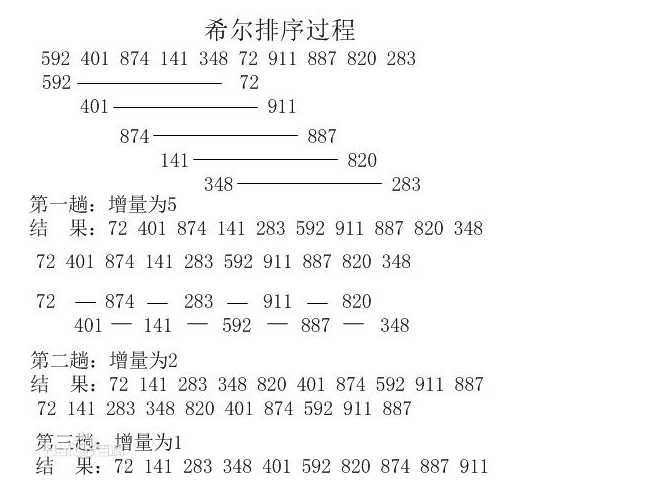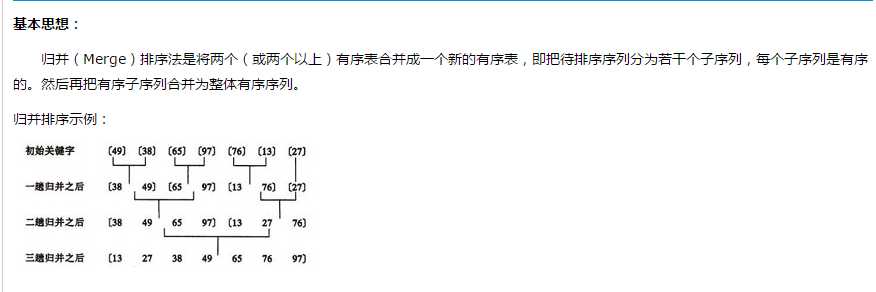标签:count bsp com 左右 第一个 递归 元素 交换 cts
1.直接插入排序:
如何写成代码:
首先设定插入次数,即循环次数,for(int i=1;i<length;i++),1个数的那次不用插入。
设定插入数和得到已经排好序列的最后一个数的位数。insertNum和j=i-1。
从最后一个数开始向前循环,如果插入数小于当前数,就将当前数向后移动一位。
将当前数放置到空着的位置,即j+1。
代码实现如下:
public class InsertSort {
public static void insertSort(int[] a){
int length = a.length; //求取出length是为了提高速度
int insertNum ;
for(int i=1;i<length;i++){//要插入的次数
insertNum = a[i];
int j = i-1;
while(j>=0&&insertNum<a[j]){
a[j+1] = a[j];
j--;
}
//比如3 6 5,此时找到j为3,则在j+1的位置插入5。
a[j+1]=insertNum;
}
}
public static void main(String[] args) {
int[] a= {3,6,5};
insertSort(a);
System.out.println(Arrays.toString(a));
}
}
2.希尔排序:

public class SheelSort {
public static void SheelSort(int[] a){
int d = a.length;
while(d!=0){
d = d/2;
for(int x = 0; x < d; x++){//分的组数
for(int i=x+d; i<a.length; i=i+d){//组中的元素,从第2个开始
int j = i-d; //j为有序序列最后一位的位数
int temp = a[i]; //要插入的元素
for(; j>=0&&temp<a[j]; j=j-d){
a[j+d] = a[j];//向后移动d位
}
a[j+d] = temp;
}
}
}
}
public static void main(String[] args) {
int[] a ={592,401,874,141,348,72,911,887,820,283};
SheelSort(a);
System.out.println(Arrays.toString(a));
}
}
3.简单选择排序
public class SelectSort {
public static void selectSort(int[] a){
int len = a.length;
int minIndex,temp;
for(int i=0;i<len-1;i++){
minIndex = i;
for(int j=i+1;j<len;j++){
if(a[j]<a[minIndex]){
minIndex = j;
}
}
temp = a[i];
a[i] = a[minIndex];
a[minIndex] = temp;
}
}
public static void main(String[] args) {
int[] a ={592,401,874,141,348,72,911,887,820,283};
selectSort(a);
System.out.println(Arrays.toString(a));
}
}
4.堆排序
对简单选择排序的优化。
将序列构建成大顶堆。
将根节点与最后一个节点交换,然后断开最后一个节点。
重复第一、二步,直到所有节点断开。
堆排序关键要理解,从下往上,调整节点,比如说,这棵树一共3层,那么将第2层的树作为根节点,保证它的子节点都小于它,此时,如果调整第1层,若其左节点是最大值,必然会将第一层根节点和左节点进行交换,以保证第1层满足最大堆的结构,但此时,有可能会破坏第1层的左节点的最大堆结构,因此需要对这个第1层的左节点的堆进行重新调整。-------------这是关键要理解的地方!
public class HeapSort {
public HeapSort(){
}
public static void heapSort(int[] a){
System.out.println("开始排序");
int arrayLength=a.length;
//循环建堆
for(int i=0;i<arrayLength-1;i++){
//建堆
buildMaxHeap(a,arrayLength-1-i);
//交换堆顶和最后一个元素
swap(a,0,arrayLength-1-i);
}
}
private static void swap(int[] data, int i, int j) {
// TODO Auto-generated method stub
int tmp=data[i];
data[i]=data[j];
data[j]=tmp;
}
//对data数组从0到lastIndex建大顶堆
private static void buildMaxHeap(int[] data, int lastIndex) {
//从lastIndex处节点(最后一个节点)的父节点开始
for(int i=(lastIndex-1)/2;i>=0;i--){
//k保存正在判断的节点
int k=i;
//如果当前k节点的子节点存在
while(k*2+1<=lastIndex){
//k节点的左子节点的索引
int biggerIndex=2*k+1;
//如果biggerIndex小于lastIndex,即biggerIndex+1代表的k节点的右子节点存在
if(biggerIndex<lastIndex){
//若果右子节点的值较大
if(data[biggerIndex]<data[biggerIndex+1]){
//biggerIndex总是记录较大子节点的索引
biggerIndex++;
}
}
//如果k节点的值小于其较大的子节点的值
if(data[k]<data[biggerIndex]){
//交换他们
swap(data,k,biggerIndex);
//将biggerIndex赋予k,开始while循环的下一次循环,重新保证k节点的值大于其左右子节点的值
//如果不理解,那么请使用打断点的方式来运行,则可发现,当i=0时,由于节点1和节点0发生了交换,因此需要重新调整1节点的堆结构,保证
//1节点的值仍然大于其左右节点的值
k=biggerIndex;
}else{
break;
}
}
}
}
public static void main(String[] args) {
int a[] = {7,13,6,43,5,23,4};
heapSort(a);
System.out.println(Arrays.toString(a));
}
}
5.冒泡排序
将序列中所有元素两两比较,将最大的放在最后面。
将剩余序列中所有元素两两比较,将最大的放在最后面。
重复第二步,直到只剩下一个数。
如何写成代码:
设置循环次数。
设置开始比较的位数,和结束的位数。
两两比较,将最小的放到前面去。
重复2、3步,直到循环次数完毕。
public class BubbleSort {
public static void bubbleSort(int[] a){
boolean isSorted = true;
for(int i=0;i<a.length-1&&isSorted;i++){
isSorted = false;
for(int j=0;j<a.length-1-i;j++){
if(a[j]>a[j+1]){
int temp = a[j];
a[j] = a[j+1];
a[j+1] = temp;
isSorted = true;//内循环如果发生了交换,则证明还在继续排序
}
}
//如果经过1趟就已经排序完毕,那么第2趟结束后,isSorted = false; ,此时,
//外循环可以根据isSorted的标记状态提前结束。
}
}
public static void main(String[] args) {
int[] a ={592,401,874,141,348,72,911,887,820,283};
bubbleSort(a);
System.out.println(Arrays.toString(a));
}
}
6.快速排序
public class QuickSort {
/**
* 查找出中轴(默认是最低位low)的在numbers数组排序后所在位置
*
* @param numbers 带查找数组
* @param low 开始位置
* @param high 结束位置
* @return 中轴所在位置
*/
public static int getMiddle(int[] numbers, int low,int high)
{
int temp = numbers[low]; //数组的第一个作为中轴
while(low < high)
{
while(low < high && numbers[high] > temp)
{
high--;
}
numbers[low] = numbers[high];//比中轴小的记录移到低端
while(low < high && numbers[low] < temp)
{
low++;
}
numbers[high] = numbers[low] ; //比中轴大的记录移到高端
}
numbers[low] = temp ; //中轴记录到尾
return low ; // 返回中轴的位置
}
/**
*
* @param numbers 带排序数组
* @param low 开始位置
* @param high 结束位置
*/
public static void quickSort(int[] numbers,int low,int high)
{
if(low < high)
{
int middle = getMiddle(numbers,low,high); //将numbers数组进行一分为二
quickSort(numbers, low, middle-1); //对低字段表进行递归排序
quickSort(numbers, middle+1, high); //对高字段表进行递归排序
}
}
/**
* 快速排序
* @param numbers 带排序数组
*/
public static void quick(int[] numbers)
{
if(numbers.length > 0) //查看数组是否为空
{
quickSort(numbers, 0, numbers.length-1);
}
}
public static void main(String[] args) {
int a[] = {6,7,8,5,3,12};
quick(a);
System.out.println(Arrays.toString(a));
}
}
7.归并排序

public class MergeSort {
/**
* 归并排序
* 简介:将两个(或两个以上)有序表合并成一个新的有序表 即把待排序序列分为若干个子序列,每个子序列是有序的。然后再把有序子序列合并为整体有序序列
* 时间复杂度为O(nlogn)
* 稳定排序方式
* @param nums 待排序数组
* @return 输出有序数组
*/
public static int[] sort(int[] nums, int low, int high) {
int mid = (low + high) / 2;
if (low < high) {
// 左边
sort(nums, low, mid);
// 右边
sort(nums, mid + 1, high);
// 左右归并
merge(nums, low, mid, high);
}
return nums;
}
public static void merge(int[] nums, int low, int mid, int high) {
int[] temp = new int[high - low + 1];
int i = low;// 左指针
int j = mid + 1;// 右指针
int k = 0;
// 把较小的数先移到新数组中
while (i <= mid && j <= high) {
if (nums[i] < nums[j]) {
temp[k++] = nums[i++];
} else {
temp[k++] = nums[j++];
}
}
// 把左边剩余的数移入数组
while (i <= mid) {
temp[k++] = nums[i++];
}
// 把右边边剩余的数移入数组
while (j <= high) {
temp[k++] = nums[j++];
}
// 把新数组中的数覆盖nums数组
for (int k2 = 0; k2 < temp.length; k2++) {
nums[k2 + low] = temp[k2];
}
}
// 归并排序的实现
public static void main(String[] args) {
int[] nums = { 2, 7, 8, 3, 1, 6, 9, 0, 5, 4 };
MergeSort.sort(nums, 0, nums.length-1);
System.out.println(Arrays.toString(nums));
}
}
8.基数排序
/*
* 对于一个int数组,请编写一个基数排序算法,对数组元素排序。
给定一个int数组A及数组的大小n,请返回排序后的数组。保证元素均小于等于2000。
测试样例:
[1,2,3,5,2,3],6
[1,2,2,3,3,5]
*/
public class RadisSort {
// 各位装通法
public static int[] radixSort(int[] A, int n) {
//首先确定排序的趟数;
int max=A[0];
for(int i=1;i<n;i++){
if(A[i]>max){
max=A[i];
}
}
int time=0;
//判断位数;
while(max>0){
max/=10;
time++;
}
int length = n;
int divisor = 1;// 定义每一轮的除数,1,10,100...
int[][] bucket = new int[10][length];// 定义了10个桶,以防每一位都一样全部放入一个桶中
int[] count = new int[10];// 统计每个桶中实际存放的元素个数
int digit;// 获取元素中对应位上的数字,即装入那个桶
for (int i = 1; i <= time; i++) {// 经过4次装通操作,排序完成
for (int temp : A) {// 计算入桶
digit = (temp / divisor) % 10;
bucket[digit][count[digit]++] = temp;
}
int k = 0;// 被排序数组的下标
for (int b = 0; b < 10; b++) {// 从0到9号桶按照顺序取出
if (count[b] == 0)// 如果这个桶中没有元素放入,那么跳过
continue;
for (int w = 0; w < count[b]; w++) {
A[k++] = bucket[b][w];
}
count[b] = 0;// 桶中的元素已经全部取出,计数器归零
}
divisor *= 10;
}
return A;
}
public static void main(String[] args) {
int a[] = {1,2,3,5,2,3};
System.out.println(Arrays.toString(radixSort(a, a.length)));
}
}
8大排序算法分析:
时间复杂度:
空间复杂度:
稳定性:
总结。
标签:count bsp com 左右 第一个 递归 元素 交换 cts
原文地址:http://www.cnblogs.com/lchzls/p/6709325.html